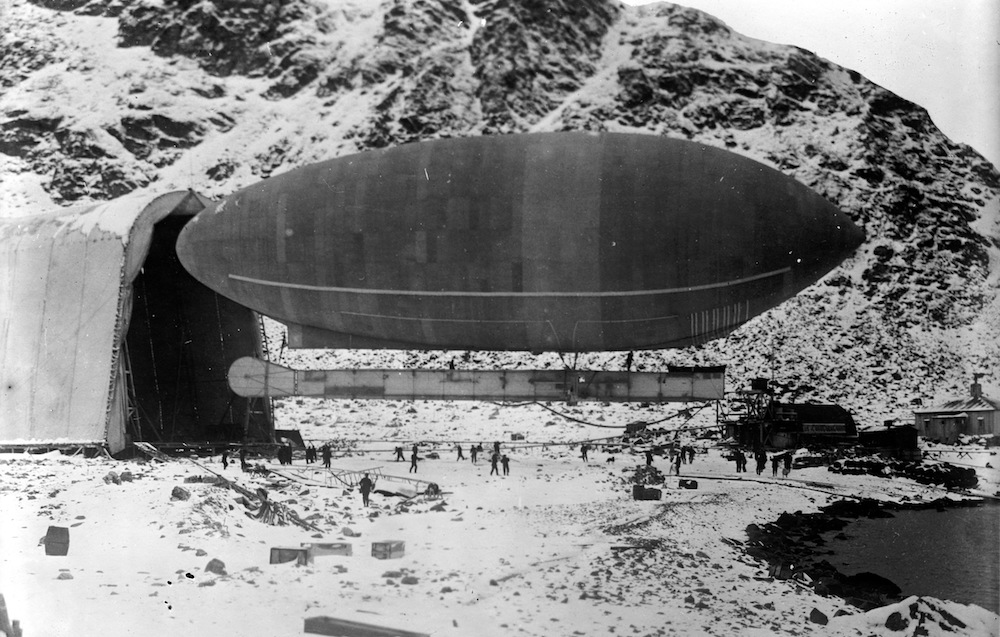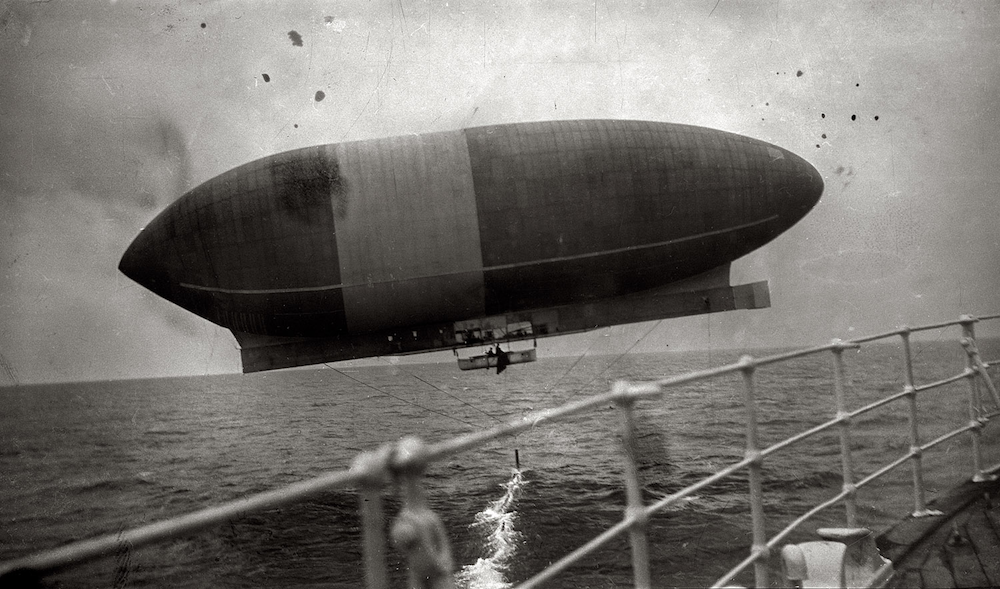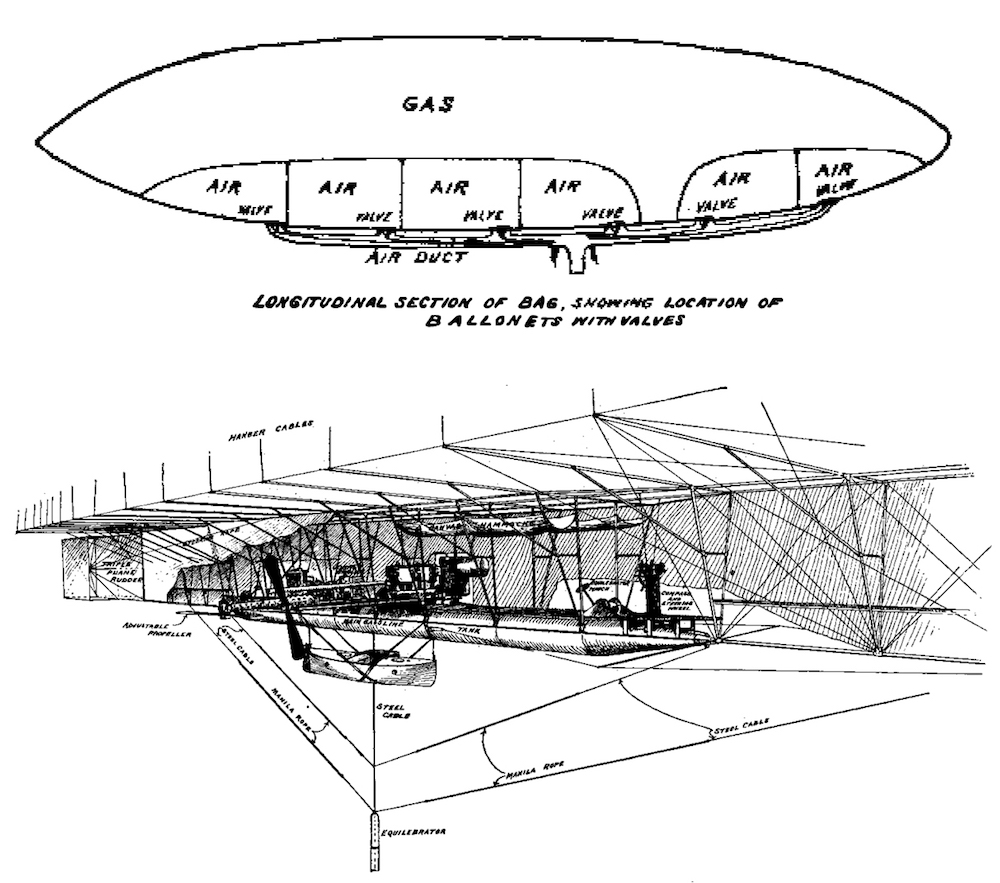October 17, 2016
106 Years Ago Today
...the airship America broke records and achieved several firsts.

 America photographed from RMSTrent. Note the visible "plug" in the envelope where the ship was enlarged & the equillibrator trailing in the water..
America photographed from RMSTrent. Note the visible "plug" in the envelope where the ship was enlarged & the equillibrator trailing in the water..
The ship was the brainchild of reporter/adventurer Walter Wellman and was initially financed by the Chicago Tribune, being designed and built for an attempt to be the first to reach the north pole. The aircraft was actually built in France, which was closer to Norway and allowed the designers to use the considerable expertise and physical plant of French balloon manufacturers, and presumably gain some input from the Gaelic airship pioneers. The craft, was, however, quite distinctive. America was a semi-rigid dirigible with a number of innovative features including swiveling airscrews capable of providing vectored thrust.

America, as built, about to make one of her attempts to reach the pole.
In 1906 the airship left Spitsbergen bound for the pole, but suffered from total engine failure. However, the crew managed to return as a balloon. The engine proved unrepairable and the ship was broken down and shipped to France for repairs. After the installation of a new engine the craft returned in 1907 and made 2 more attempts, however, both were stymied by abominable weather. The ship was shipped out again this tome to America and had it's envelope enlarged, had newer, more powerful engines installed, an electrical system including electric lights, and a wireless set was fitted, as was a lifeboat and a peculiar altitude regulator called an equillibrator, described here.
The device was a 300-foot long steel cable with 30 steel tanks containing gasoline and 40 wooden blocks. Each steel tank was 4-feet long and 9 inches in diameter and weighed about 100 pounds when filled with gasoline; the concave end of one tank fit into the convex end of another, like a ball and socket joint, and was padded with felt to absorb shocks and minimize wear and abrasion. The far end of the device consisted of 40 solid wooden blocks, tapering in diameter like the tail of a snake, that would float on the surface.
This was intended to compensate for day/night changes in buoyancy, without permanently dropping ballast. This was obviously a hazard to people on the ground, but with Robert E. Peary having gotten to the north pole in 1909. Wellman and the ship's designer, Melvin Vaniman had set their sights on a different "first", one that would push their little airship to the limits of it's capability. Their new goal was to cross the Atlantic by air, and for this, the equillibrator actually made sense as it had the potential to minimize losses of ballast and hydrogen.


America as refitted.
On October 15, 1910 America took off from Atlantic city New Jersey. Almost at once, things began to go wrong. The ship's propellors set for full vertical thrust kicked up a spectacular sandstorm. Moments after takeoff a loud screech was heard and investigation revealed the presence of a terrified cat that had stowed away in a box near the engine. He was named Kiddo. Engine trouble quickly ensued and and the ship continued on one engine. Attempts at repair proved futile as it was discovered that the engine had ingested a good deal of sand that had been kicked up during takeoff and was a total loss. It was decided to disassemble the other engine and clean it...but engine number two chose that moment to die.
The second engine was not completely wrecked and was repairable, but a ballasting error resulted in considerable loss of hydrogen. Over the next day, a storm came up and one engine was not enough to overcome the strong winds which pushed the ship far to the south.
The ship was far off course and the second engine became intermittent, so it was decided to abandon the flight. On the 17th, just north of Bermuda, the airship, now effectively a balloon spotted a British mail packet, the S.S. Trent, and hailed them via wireless using CQD (the predecessor to SOS). All six crewmen and Kiddo got into the lifeboat and were picked up by Trent, however, before a hawser could be attached, America, relieved of the weight of the lifeboat shot into the sky and was never seen again.
 America photographed from RMSTrent. Note the visible "plug" in the envelope where the ship was enlarged & the equillibrator trailing in the water..
America photographed from RMSTrent. Note the visible "plug" in the envelope where the ship was enlarged & the equillibrator trailing in the water..The flight, while unsucsessful, had a number of firsts.
2: Longest duration flight to that date by a considerable margin.
3: Longest distance covered by an aircraft in a single flight (over 1000 miles), also by a considerable margin.
4: First radio transmission from an aircraft was "Roy come and get this goddamned cat!"
5: First distress signal sent from an aircraft.
6: First launch of a boat from an aircraft.
7: First air-sea rescue....actually a sea-air rescue.
If things had broken just a bit different, America probably would have made it. An air intake filter would have prevented the loss of the engines. Of course this was one of the learning experiences that caused people to adopt them
Wellman threw in the towel on aviation after this, but Vaniman attempted another crossing of the Atlantic the next year in an improved and enlarged version of America named Akron (the first airship manufactured by Goodyear). Tragically, Akron exploded shortly after launch with the loss of all hands. The Atlantic would not be crossed by air until 1919.
If you are interested in more stuff involving airships, J.C.Carlton has you covered.
Posted by: The Brickmuppet at
07:08 AM
| Comments (1)
| Add Comment
Post contains 919 words, total size 8 kb.
October 05, 2016
It's Time to Have a Little Talk With HR
Scott Lowther notes another scolderiffic luddite pantywaist killjoy douche-mongler who is all upset about Elon Musks rather ambitious Mars plan. The piece is a sad commentary on our culture but would not really be worth noting were it not for one tidbit that Mr. Lowther turned up about this Calvinistic sourpuss who thinks that the ideal model for society is a pot of crabs.

EMPLOYMENT• Manager of Communications , NASA Astrobiology Program, Jan. 2007 – present.• Communication research, planning, and analysis, NASA Planetary Protection Office, Sept. 2002 – 2006.• Director of Communications , SPACEHAB, Inc., Washington, D.C., Sept. 1999 – Aug. 2002 .• Chancellor’s Fellow (1996 – 97, Knight Fellow (1997 – 99) , Indiana U. School of Journalism.• Director of Science Communication, Life Sciences Division, NASA HQ, Oct. 1994 – Aug. 1996.• Manager of education and out reach, exploration office, NASA HQ, Dec. 1993 – Oct. 1994 .• Senior editor/analyst, BDM International, April 1990 – December 1993.• Editor, Lockheed Engineering & Sciences Co., July 1988 – April 1990.• Senior editor for space, Air & Space/Smithsonian magazine, December 1985 – July 1988.• Public affairs officer, National Commission on Space, Sept. – Dec. 1985.• Consultant, National Science Foundation, August – September 1985 .• Editor, Space Business News, June 1983 – August 1985.

"So...she's diametrically opposed to the Raison d ' être
of the organization, and is more generally an enemy of reason.
Why is NASA paying this person?"
Posted by: The Brickmuppet at
05:23 AM
| No Comments
| Add Comment
Post contains 257 words, total size 3 kb.
<< Page 1 of 1 >>
36kb generated in CPU 0.6918, elapsed 1.5303 seconds.
68 queries taking 1.3932 seconds, 272 records returned.
Powered by Minx 1.1.6c-pink.
68 queries taking 1.3932 seconds, 272 records returned.
Powered by Minx 1.1.6c-pink.









